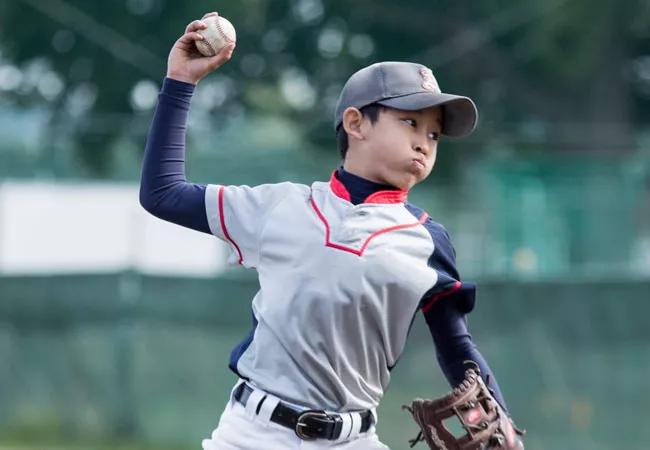Elbow surgeries are on the rise in pitchers

Elbow injuries are common in baseball players, especially pitchers. That’s because throwing a ball over your head is about one of the most stressful things you can do to your elbow. And for pitchers, all that wear and tear can catch up quickly.
Advertisement
Cleveland Clinic is a non-profit academic medical center. Advertising on our site helps support our mission. We do not endorse non-Cleveland Clinic products or services. Policy
A rise in elbow injuries has led to a big increase in a surgery known popularly as Tommy John surgery.
And adding further demand for the surgery is an urban legend-level claim: Tommy John surgery, some people will tell you, improves pitchers’ velocity.
Not the case, says Mark Schickendantz, MD, orthopaedic surgeon and head team physician for the Cleveland Guardians.
“The surgery may help you throw better than you did with a damaged UCL, but it isn’t a performance enhancement,” he says. “Tommy John surgery is not an elective surgery for ball players trying to improve their ability. It should be performed only when necessary.”
What is Tommy John surgery and why is it so common? Dr. Schickendantz explains.
Baseball fans call it Tommy John after the Los Angeles Dodger who was the first person to undergo it. But the medical term for the surgery is ulnar collateral ligament reconstruction.
Your ulnar collateral ligament (UCL) is the stabilizing band on the inside of your elbow, where your arm bends. With repetitive use, the UCL becomes worn, strained and swollen. It can also tear or pull away from your bone.
People with UCL injuries have pain and tenderness in their elbow. They can also experience weakness or lose the grip in their affected hand.
Advertisement
“A UCL injury is usually associated with pain on the inside of your elbow during throwing, specifically as you transition from late cocking to forward acceleration,” Dr. Schickendantz explains. “Some players hear a ‘pop’ from the inside of their elbow, but that’s not common. A pop can indicate a very bad UCL injury.”
Most UCL injuries occur gradually from overuse. The more you throw, the more your UCL wears down. It gets thinner — like the knees on an old pair of jeans — and becomes more painful over time.
Tommy John surgery usually is recommended only when a UCL has completely torn away from your bone and won’t heal on its own. The procedure is a full reconstruction. Surgeons take a tendon from another part of your body or from a donor and attach it as a whole new ligament.
But not all UCL injuries require Tommy John surgery. Many heal on their own. Or your doctor may recommend physical therapy or biologic injections. They can also use techniques that repair — rather than replace — your UCL.
Dr. Schickendantz says doctors today are performing more Tommy John surgeries than ever.
One reason may be that kids are starting to play baseball younger. And kids’ baseball teams are becoming more competitive than in the past. Kids are encouraged to throw harder and play year-round, not giving their elbow time to rest and recover.
Over time, that wear adds up. So, by the time a young pitcher is in the major, minors or even in high school, their UCL has been compromised to the point of needing surgery.
Dr. Schickendantz says youth and adolescent players, as well as their parents and coaches, should follow USA Baseball guidelines on limiting pitch counts and number of days on the mound.
Young athletes should not throw year-round. They should have at least two (ideally three) months off from pitching each year.
“I tell my patients, ‘If you have the talent, it will still be there eight weeks from now,’” Dr. Schickendantz says. “Resting your arm is an important part of keeping at the top of your game.”
Some people will tell you that Tommy John surgery has become more popular because a surgically enhanced pitching elbow is a competitive advantage. Some people argue that surgery can increase your velocity (pitching speed).
Not so, Dr. Schickendantz reiterates.
“Surgery will not help you perform any better than you could before your injury. Recovery can take a year or even more. And often, pitchers can use that time to work on mechanics and may see an improvement in their game. But the surgery itself doesn’t make you a better pitcher.”
Advertisement
Also, as with any surgery, there are risks to Tommy John surgery. Only about 80% to 83% of professional baseball players return to the same level of performance after having Tommy John surgery. For high school players (age 18 and younger), it’s less — around 70% to 73%.
Many pitchers experience soreness after pitching. If you’re feeling elbow pain that’s different from your typical post-pitch soreness, Dr. Schickendantz suggests watching and waiting for a few days.
If the pain persists, take a week off from throwing. Apply ice to the inside of your elbow and take anti-inflammatory pain relievers. Return to throwing gradually.
If your pain persists, Dr. Schickendantz says it’s time to see a healthcare provider, like a sports medicine specialist. They can run tests to look at the cause of the pain and suggest routes for treatment.
Advertisement
Learn more about our editorial process.
Advertisement

Most recommended precautions center around minimizing bruising or swelling

Even one drink can have an impact on your cognitive function leading to slurred speech, blurred vision and impaired memory

Understand who may (and may not) benefit

Lorem ipsum dolor sit amet. Et odio Quis vel ipsam omnis eum alias deleniti et placeat impedit non voluptas galisum hic autem enim et cupiditate aliquid. Est beatae quidem non facilis autem ut commodi nisi aut tempore rerum et dolores voluptatem cum enim optio id sapiente quasi. Ad laboriosam officiis 33 cupiditate sequi ea voluptatum consectetur qui necessitatibus voluptate et quasi doloremque et facere explicabo quo explicabo officia

Seeking help through therapy can be an important step in improving your quality of life when you have UC

Type 2 diabetes isn’t inevitable with these dietary changes

Applying a hot or cold compress can help with pain